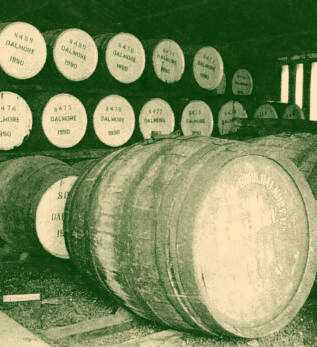Dalmore, Cathedral ofthe North
Of oilrigs, footballsand alligators
The distillery, unlike its whisky, is hard tofind. It isn't one of your showy, catering for busloads ofgrannies, sort of distilleries. Indeed there is a sign at theentrance, saying keep out. Admittance is on business only, unlessyou have an appointment and if you do, you have to find theplace, which is not easy.
Going North, the A9 leaves Inverness and crosses the KessockBridge, the improbably green Black Isle and the causeway over theCromarty Firth. As the road turns eastward, you see oilrigslittering the firth, vast and rusting, the heroic relics of atitanic technology. To reach the distillery, you take the B817through the village of Alness. Just after you cross the mainroad, there is a gate on the right and a driveway which bringsyou to the shore and the oil rigs again.
There is a feeling of being right down at sea level and thecar is parked within feet of the tidewrack. There is a jumble ofold buildings, all in yellow-red stone, with, here and there,little courtyards and stone troughs through which waters flow.There are a lot of relatively new buildings as well, but thefeeling throughout is of the modern being fitted into theancient, of an organic compromise between the needs of thepresent and the presence of the past. And it is not the showypresence of the heritage centre, for, remember, this is adistillery which does not encourage visitors.
 Drew Sinclair shows usround. Drew is assistant manager. Steve Tullevich, the manager,has had to go to a funeral. Drew started here as a storeman 28years ago and progressed through every job in the distillery, asdid his father before him. He introduces us to Donald Dunnett,the head warehouseman. Dunnett, like Sinclair, is a name commonin the northeast for the best part of a millennium. Donald'sthree sons work in the distillery.
Drew Sinclair shows usround. Drew is assistant manager. Steve Tullevich, the manager,has had to go to a funeral. Drew started here as a storeman 28years ago and progressed through every job in the distillery, asdid his father before him. He introduces us to Donald Dunnett,the head warehouseman. Dunnett, like Sinclair, is a name commonin the northeast for the best part of a millennium. Donald'sthree sons work in the distillery.
Drew leads us past the malt bins to the milling machine.Dimly, in a corner, sits a single-cylinder, horizontal steamengine which once was used to drive the malt conveyor. Another, avertical engine this time, drove the mill. The paint on theengine is still quite fresh and you have the feeling that ifsomeone were to open a steam valve, the wheels would slowly beginto turn. The mill room itself is very grand, with themaroon-painted mill and the dressing machine raised above eyelevel. The mill grinds fourteen tons of malt per mash, which goesinto a stainless-steel mashtun, and from there the worts aretransferred to eight wooden washbacks.
The draff, which is what remains of the malt after its sugarshave been extracted, is blown via wide pipes into a hopper. Twoplastic footballs lie, incongruously, on a rack. Drew tells usthat the footballs are used to clear the pipes. They fit the boreperfectly and are blown through, forcing the draff ahead of them.Whether the footballs just happen to fit the pipes, or the pipeswere made with footballs in mind, Drew does not mention.
There is a wooden-topped wash charger, the handles, alsowooden, of whose paddles protrude from the top. The wash chargesfour curiously flat-topped wash stills. The stillroom is notlarge as such things go, but it has the feeling of space whichyou get in a cathedral. At either end of the nave is a group offour stills, two wash and two spirit. In one transept are thespirit safes, four of them, in brass. The stillman has an air ofrelaxed attention, which is common to stillmen and alligators.
 The spirit stills are oddaffairs. The bulb of the still is as elegant an onion shape asany other, but instead of a pipe rising smoothly as though theonion had sprouted, the eye is offered a cylinder of copper fromwhose top the head of the still emerges. The copper cylinderhouses a water jacket, the business of which is to bring about aninitial condensation, so that only the most volatile vapours makeit over to the condenser proper.
The spirit stills are oddaffairs. The bulb of the still is as elegant an onion shape asany other, but instead of a pipe rising smoothly as though theonion had sprouted, the eye is offered a cylinder of copper fromwhose top the head of the still emerges. The copper cylinderhouses a water jacket, the business of which is to bring about aninitial condensation, so that only the most volatile vapours makeit over to the condenser proper.
The stills run very slowly, and the stillman takes a narrowcut, to ensure that only the very best of spirit leaves thestill. The result is as evident in the new spirit as it is in themature whisky, for the spirit is perfectly palatable, thoughfresh from the still. It smells strongly of malted barley, whichought not to be surprising save that mature whisky, by and large,doesn't.
Then via the filling store to cask and warehouse. Dalmore usesboth sherry and bourbon wood, which it mixes for its proprietarymalt. It is in great demand as a whisky for blending and it makesits distinctive contribution to a number of well-known blends, aswell as having substantial, increasing sales as a single malt. Wetake a dram with Drew in Steve's oak-panelled office, in what wasonce the Excise office. We protest a little at the size of thedrams which Drew pours in crystal glasses, but he explains thatany less would be an insult to the glass. The tumbler as asentient - and sensitive - being is a new concept which must besavoured, an activity facilitated by the Dalmore. It has aproperty which we sometimes observe and which seems mysteriouslyto be an indicator of quality: a propensity to evaporate rapidlyfrom the glass. Perhaps Drew's pouring policy is a prophylactic.Happily, Dalmore distillery is in full production, and the remedylies readily to hand.
Phillip Hills

If you have comments about thissite, please contact the webmaster. Unless otherwise noted, all information in this siteŠ The Scotch Malt Whisky Society, Edinburgh, Scotland, 1997.
 Drew Sinclair shows usround. Drew is assistant manager. Steve Tullevich, the manager,has had to go to a funeral. Drew started here as a storeman 28years ago and progressed through every job in the distillery, asdid his father before him. He introduces us to Donald Dunnett,the head warehouseman. Dunnett, like Sinclair, is a name commonin the northeast for the best part of a millennium. Donald'sthree sons work in the distillery.
Drew Sinclair shows usround. Drew is assistant manager. Steve Tullevich, the manager,has had to go to a funeral. Drew started here as a storeman 28years ago and progressed through every job in the distillery, asdid his father before him. He introduces us to Donald Dunnett,the head warehouseman. Dunnett, like Sinclair, is a name commonin the northeast for the best part of a millennium. Donald'sthree sons work in the distillery.  The spirit stills are oddaffairs. The bulb of the still is as elegant an onion shape asany other, but instead of a pipe rising smoothly as though theonion had sprouted, the eye is offered a cylinder of copper fromwhose top the head of the still emerges. The copper cylinderhouses a water jacket, the business of which is to bring about aninitial condensation, so that only the most volatile vapours makeit over to the condenser proper.
The spirit stills are oddaffairs. The bulb of the still is as elegant an onion shape asany other, but instead of a pipe rising smoothly as though theonion had sprouted, the eye is offered a cylinder of copper fromwhose top the head of the still emerges. The copper cylinderhouses a water jacket, the business of which is to bring about aninitial condensation, so that only the most volatile vapours makeit over to the condenser proper. 